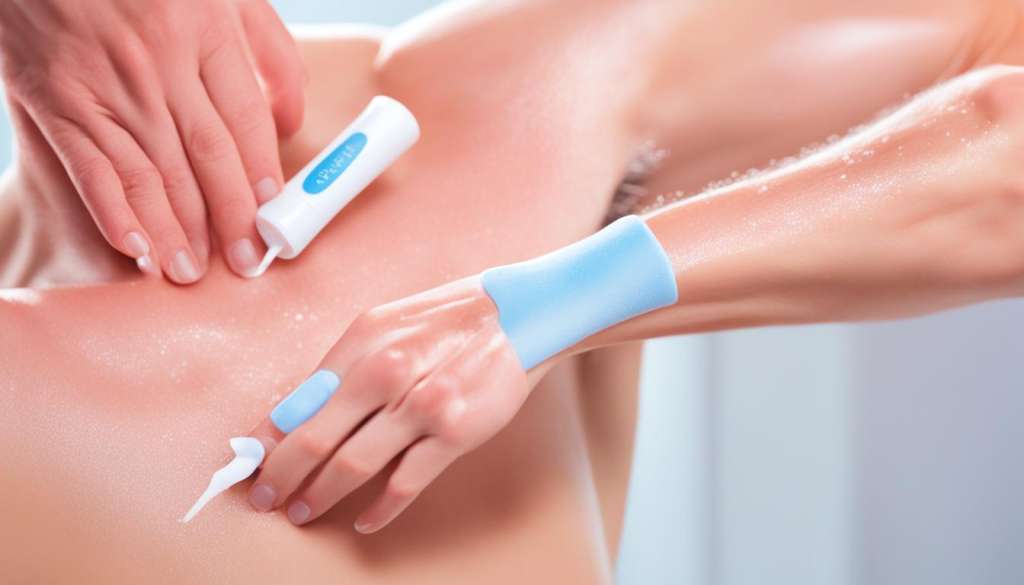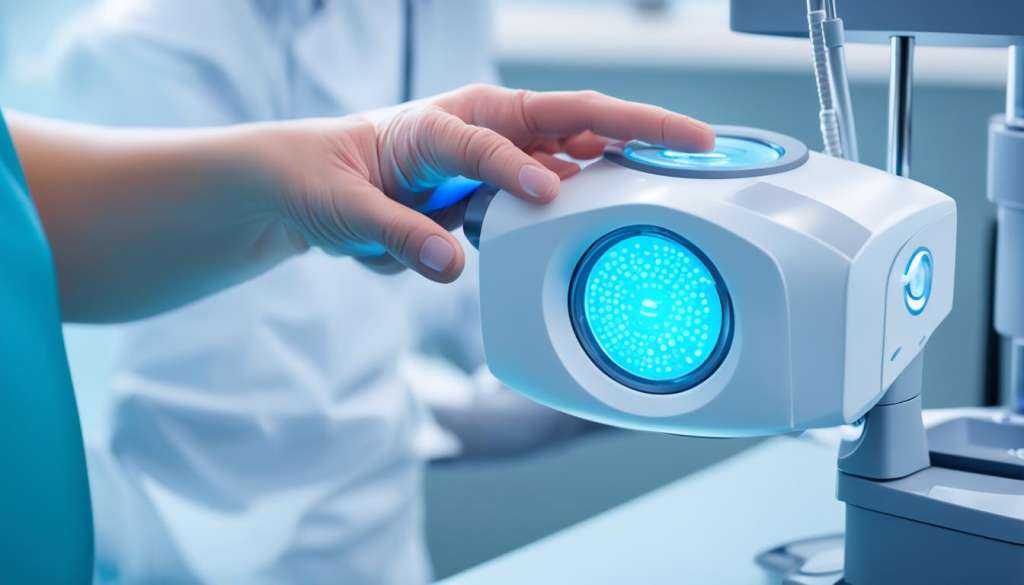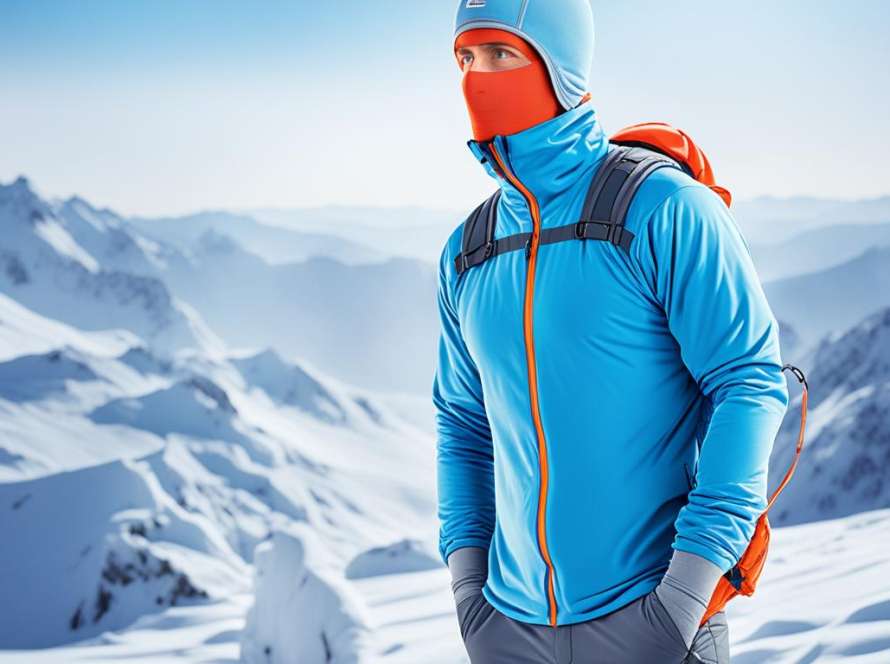This guide will help you manage excessive sweating. If you’re one of the millions dealing with hyperhidrosis, you’re not alone. This condition affects about 3% of Americans, causing excessive sweating that can disrupt daily life.
Antiperspirants are your first line of defense against excessive sweating. Unlike deodorants, which only mask odor, antiperspirants contain aluminum salts. These salts form plugs in sweat glands, reducing perspiration. You can find over-the-counter options for mild cases, or seek prescription-strength alternatives for more severe hyperhidrosis.
This guide will cover various sweat management techniques. You’ll learn about antiperspirants, medical treatments, and lifestyle changes. By understanding your options, you can take control of your sweating and boost your confidence.
Understanding Hyperhidrosis and Excessive Sweating
Hyperhidrosis is a condition where you sweat too much, even when it’s not hot. It affects millions globally, making daily life tough. Let’s explore this condition to understand its types, how common it is, and its effects.
Definition and Types of Hyperhidrosis
There are two main types of hyperhidrosis: primary and secondary. Primary hyperhidrosis has no known cause and often starts in youth. Secondary hyperhidrosis is caused by other health issues or medicines.
| Type | Cause | Onset | Affected Areas |
|---|---|---|---|
| Primary Hyperhidrosis | Unknown | Childhood/Adolescence | Localized (e.g., palms, feet, underarms) |
| Secondary Hyperhidrosis | Medical conditions or medications | Adulthood | Generalized or localized |
Prevalence and Impact on Daily Life
About 3% of Americans have hyperhidrosis. It can really affect life, causing social anxiety and discomfort. People with this condition often find simple tasks hard, like shaking hands or picking clothes.
Common Triggers and Affected Areas
People with hyperhidrosis have overactive sweat glands. This means they sweat more than needed. Common things that make it worse include stress, heat, spicy foods, and caffeine. The most common places it happens are:
- Underarms
- Palms of hands
- Soles of feet
- Face and scalp
Knowing about hyperhidrosis helps in managing it better. If you’re sweating too much, seeing a doctor can help find the right treatment for you.
The Science Behind Sweat: Why We Perspire
Your body has a cool system that starts working when it gets hot. Sweat glands are key in this process. They release fluid on your skin to keep your body at the right temperature. This helps your body work well.
Sweating comes from eccrine glands all over your skin. These glands make a clear, smell-less fluid that’s mostly water and salt. When you get hot from working out, being in a warm place, or feeling stressed, these glands work harder.
Evaporative cooling is the magic behind sweating. As sweat evaporates, it takes heat away from your body. This lowers your temperature quickly and efficiently. It can cool your blood and skin by several degrees in just a few minutes.
| Sweat Gland Type | Location | Primary Function |
|---|---|---|
| Eccrine | All over body | Thermoregulation |
| Apocrine | Armpits, groin | Produce scented sweat |
While sweating is key for keeping your body cool, some people sweat too much. This is called hyperhidrosis. It makes sweat glands work too much, making more sweat than needed for cooling.
Over-the-Counter Solutions for Sweat Control
Dealing with too much sweat can be tough, but there are many over-the-counter options. These products help with sweat reduction and odor control. Knowing about these solutions can help you pick the best one for you.
Antiperspirants vs. Deodorants
Antiperspirants and deodorants have different jobs in managing sweat. Antiperspirants use aluminum chloride to block sweat glands and reduce sweat. Deodorants work by hiding odors without stopping sweat.
| Product | Primary Function | Active Ingredient |
|---|---|---|
| Antiperspirant | Sweat reduction | Aluminum chloride |
| Deodorant | Odor control | Fragrances, antibacterial agents |
Choosing the Right Antiperspirant Strength
Antiperspirants in stores have 6-20% aluminum chloride. If you need more protection, clinical strength antiperspirants have more. Think about how much you sweat to pick the right strength.
Application Techniques for Maximum Effectiveness
To get the most out of antiperspirants, put them on dry skin before bed. This lets the ingredients work best when sweat glands are quiet. Wash it off in the morning for the best effect.

By understanding the differences between products and how to use them, you can control excessive sweating. This makes your daily life more comfortable.
Prescription Treatments for Excessive Sweating
If you struggle with too much sweating, you might need prescription treatments. Doctors often suggest topical treatments first. These include creams with aluminum chloride hexahydrate that block sweat glands.
For worse cases, anticholinergic medications can help. Glycopyrrolate and oxybutynin are common ones. You can apply them on your skin or take them by mouth. Topical treatments are usually safer.
Oral anticholinergic drugs are an option if top treatments don’t work. They stop nerve signals that make you sweat. But, they might make your mouth dry and your vision blurry.
| Treatment | Application | Pros | Cons |
|---|---|---|---|
| Aluminum Chloride Hexahydrate | Topical | First-line treatment, effective for mild cases | May cause skin irritation |
| Glycopyrrolate | Topical or Oral | Effective for moderate to severe cases | Possible side effects when taken orally |
| Oxybutynin | Topical or Oral | Can treat generalized hyperhidrosis | May cause dry mouth when taken orally |
Your doctor will help pick the best treatment for you. Remember, what works for one person might not work for another. So, be patient in finding the right solution.
Medical Procedures to Combat Hyperhidrosis
When lifestyle changes and over-the-counter treatments don’t work, medical procedures can help. These methods target sweat glands directly. They offer long-lasting relief for those with hyperhidrosis.

Iontophoresis: A Non-Invasive Approach
Iontophoresis uses a mild electrical current to block sweat glands. You put your hands or feet in water trays connected to a device. It’s painless and can reduce sweating for weeks. Regular sessions keep the effect going, making it a top choice for palmar and plantar hyperhidrosis.
Botulinum Toxin Injections: Temporary Sweat Relief
Botulinum toxin injections, or Botox, help control excessive sweating for 6-12 months. They block nerve signals to sweat glands. It works well for underarm sweating and can be used on other areas too. The treatment is quick and has little downtime.
Advanced Treatments: Microwave Therapy and Surgical Options
Microwave therapy, known as miraDry, permanently removes underarm sweat glands. It’s FDA-approved and gives lasting results. For severe cases, surgery like endoscopic thoracic sympathectomy might be an option. This surgery cuts nerves controlling sweating but can cause sweating in other areas too.
| Procedure | Duration of Effect | Invasiveness |
|---|---|---|
| Iontophoresis | Weeks | Non-invasive |
| Botox Injections | 6-12 months | Minimally invasive |
| MiraDry | Permanent | Minimally invasive |
| Sympathectomy | Permanent | Surgical |
Each procedure has its own pros and cons. Talk to a dermatologist to find the best treatment for your hyperhidrosis.
Lifestyle Changes to Manage Excessive Sweating
Dealing with too much sweat can be tough, but changing your lifestyle can help. By knowing what makes you sweat more and changing your daily habits, you can sweat less and feel more confident.
First, keep a journal to note what makes you sweat. Things like spicy foods, caffeine, and alcohol are common causes. Once you know what they are, try to avoid or cut down on them. Keeping clean is also important. Use antibacterial soap every day to fight off bacteria that cause bad smells.
Drinking enough water is key to keeping your body cool. It helps your body regulate its temperature. For extra help, try using products like underarm liners and shoe inserts that absorb sweat.
Stress can make sweating worse. Here are some ways to relax:
- Deep breathing exercises
- Progressive muscle relaxation
- Guided imagery
- Yoga or meditation
Adding these changes to your life can really make a difference. Remember, it might take some time to see changes, so stick with it. If you’re still sweating a lot, talk to a doctor for more help.
Sweat Management Guide: Clothing and Fabric Choices
Choosing the right clothes is key to managing sweat. Let’s look at fabrics and garments that keep you dry and comfy.
Moisture-Wicking Materials for Everyday Wear
For everyday, pick breathable fabrics that let air move freely. Natural fibers like cotton, wool, and silk are top choices. They soak up moisture and let your skin breathe, aiding in sweat control.
Specialized Clothing for High-Sweat Activities
For workouts or hot weather, go for sweat-resistant clothes. Choose synthetic fabrics made for moisture management. These materials pull sweat away from your skin and dry fast, keeping you cool and dry.
| Activity | Recommended Fabric | Benefits |
|---|---|---|
| Running | Polyester blend | Quick-drying, lightweight |
| Yoga | Nylon/Spandex | Stretchy, sweat-wicking |
| Hiking | Merino wool | Odor-resistant, temperature-regulating |
Underarm Shields and Other Protective Accessories
Sweat pads offer extra protection. These can be disposable or reusable, sticking to your clothes or skin to absorb sweat. They’re discreet and work well for managing underarm sweat.
Wearing loose clothes helps air flow, which cools you down. For your feet, choose shoes from natural materials and pair with moisture-wicking socks. Switch socks often and let shoes air out between uses to control foot sweating.
Diet and Nutrition: Impact on Sweat Production
Your diet greatly affects how much you sweat. Some foods make you sweat more, while others help control it. Knowing this can help you choose better foods and drinks.
Spicy foods are known to make you sweat. They have capsaicin, which makes your body think it’s too hot. This causes you to sweat as your body tries to cool down. If you sweat a lot, eating less spicy food might help.
Caffeine and alcohol can also make you sweat. They speed up your heart and make you lose water. Drinking less of these might help you sweat less.
It’s important to stay hydrated to keep your body cool. Drink water all day to stay hydrated. When you’re sweating a lot, eat foods with electrolytes like bananas and leafy greens.
Some people find eating more complex carbs helps with sweating. Foods with B-vitamins and magnesium, like whole grains and nuts, might also help. But, MSG in some foods can make you sweat, so watch out for it.
| Sweat-Triggering Foods | Sweat-Reducing Foods |
|---|---|
| Spicy dishes | Complex carbohydrates |
| Caffeine | B-vitamin rich foods |
| Alcohol | Magnesium-rich foods |
| MSG | Hydrating fruits and vegetables |
Choosing your food wisely can help reduce sweating and make you more comfortable. Everyone’s body is different, so notice how different foods affect your sweating. Adjust your diet based on what works best for you.
Stress Management Techniques to Reduce Perspiration
Stress and anxiety can make you sweat more than usual. Learning to manage these feelings can help control excessive sweating. Let’s explore some effective methods to tackle stress-induced sweating and improve your overall well-being.
Mindfulness and Meditation for Sweat Control
Practicing mindfulness and meditation can significantly reduce stress-induced sweating. These relaxation techniques help calm your mind and body, lowering your overall stress levels. Try setting aside 10-15 minutes daily for deep breathing exercises or guided meditation. You might find apps like Headspace or Calm helpful in getting started.
Exercise and Its Effect on Sweating Patterns
Regular exercise is a powerful tool for managing stress and anxiety. While you may sweat more during workouts, consistent physical activity can improve your body’s stress response over time. Aim for at least 30 minutes of moderate exercise most days of the week. Activities like yoga or swimming can be particularly beneficial for anxiety management and sweat control.
Cognitive Behavioral Therapy for Anxiety-Related Sweating
Cognitive Behavioral Therapy (CBT) can be an effective approach for managing anxiety-related sweating. This therapy helps you identify and change negative thought patterns that contribute to stress and excessive sweating. Consider working with a therapist who specializes in CBT to develop personalized strategies. Some people also find biofeedback techniques useful in gaining control over their sweating response.

